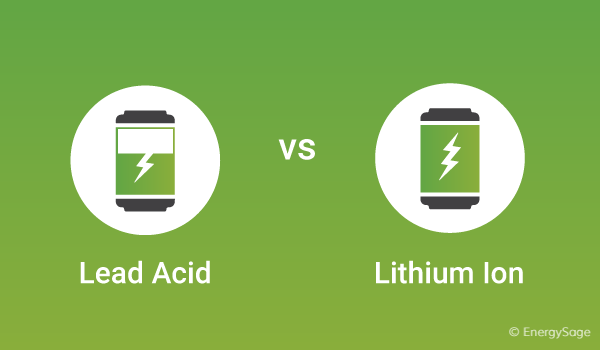
02 Feb Lithium-ion vs. lead-acid batteries overview
Battery storage is becoming an increasingly popular addition to solar energy systems. Two of the most common battery chemistry types are lithium-ion and lead-acid. As their names imply, lithium-ion batteries are made with the metal lithium, while lead-acid batteries are made with lead.
With these differences in chemistry come differences in performance and cost. While both lithium-ion and lead-acid battery options can be effective storage solutions, here’s how they stack up when compared head to head in key categories:
Lithium-ion vs. lead-acid batteries: who wins?
| LITHIUM-ION | LEAD ACID | |
| Cost | X | |
| Capacity | X | |
| Depth of discharge | X | |
| Efficiency | X | |
| Lifespan | X |
In most cases, lithium-ion battery technology is superior to lead-acid due to its reliability and efficiency, among other attributes. However, in cases of small off-grid storage systems that aren’t used regularly, less expensive lead-acid battery options can be preferable.
In detail: how do lithium-ion and lead-acid batteries compare?
Lithium-ion and lead-acid batteries can both store energy effectively, but each has unique advantages and drawbacks. Here are some important comparison points to consider when deciding on a battery type:
Cost
The one category in which lead-acid batteries seemingly outperform lithium-ion options is in their cost. A lead-acid battery system may cost hundreds or thousands of dollars less than a similarly-sized lithium-ion setup – lithium-ion batteries currently cost anywhere from $5,000 to $15,000 including installation, and this range can go higher or lower depending on the size of system you need.
While lead-acid batteries typically have lower purchase and installation costs compared to lithium-ion options, the lifetime value of a lithium-ion battery evens the scales. Below, we’ll outline other important features of each battery type to consider, and explain why these factors contribute to an overall higher value for lithium-ion battery systems.
Capacity
A battery’s capacity is a measure of how much energy can be stored (and eventually discharged) by the battery. While capacity numbers vary between battery models and manufacturers, lithium-ion battery technology has been well-proven to have a significantly higher energy density than lead-acid batteries. This means that more energy can be stored in a lithium-ion battery using the same physical space. Because you can store more energy with lithium-ion technology, you can discharge more energy, thus power more appliances for longer periods of time.
Depth of discharge
A battery’s depth of discharge is the percentage of the battery that can be safely drained of energy without damaging the battery. While it is normal to use 85 percent or more of a lithium-ion battery’s total capacity in a single cycle, lead-acid batteries should not be discharged past roughly 50 percent, as doing so negatively impacts the lifetime of the battery. The superior depth of discharge possible with lithium-ion technology means that lithium-ion batteries have an even higher effective capacity than lead-acid options, especially considering the higher energy density in lithium-ion technology mentioned above.
Efficiency
Just like solar panel efficiency, battery efficiency is an important metric to consider when comparing different options. Most lithium-ion batteries are 95 percent efficient or more, meaning that 95 percent or more of the energy stored in a lithium-ion battery is actually able to be used. Conversely, lead-acid batteries see efficiencies closer to 80 to 85 percent. Higher efficiency batteries charge faster, and similarly to the depth of discharge, improved efficiency means a higher effective battery capacity.
Lifespan
Batteries are also similar to solar panels in that they degrade over time and become less effective as they age. Discharging a battery to power your home or appliances and then recharging it with solar energy or the grid counts as one “cycle”. The numbers vary from study to study, but lithium-ion batteries generally last for several times the number of cycles as lead-acid batteries, leading to a longer effective lifespan for lithium-ion products.
When should you install a lead-acid battery vs. a lithium-ion battery?
If you need a battery backup system, both lead-acid and lithium-ion batteries can be effective options. However, it’s usually the right decision to install a lithium-ion battery given the many advantages of the technology – longer lifetime, higher efficiencies, and higher energy density. Despite having higher upfront costs, lithium-ion batteries are usually more valuable than lead-acid options.
One case where lead-acid batteries may be the better decision is in a scenario with an off-grid solar installation that isn’t used very frequently. For example, keeping a lead-acid battery on a boat or RV as a backup power source that is only used every month or so is a less expensive option than lithium-ion, and due to the lower usage rate, you’ll avoid many of the drawbacks of lead-acid technology, such as their shorter lifespan.
Storage and solar go well together – compare quotes today
With any large purchase like solar and batteries (paired or separately), you want to consider your options. You can sign up on the EnergySage Marketplace to receive turnkey quotes for solar installation from pre-screened local solar installers. If battery storage is something you’re interested in pairing with your system, we recommend adding a note in your account preferences specifying you’re interested in pricing and information about batteries. Even if a solar installer doesn’t install batteries themselves, they can design a solar panel system so that you can



